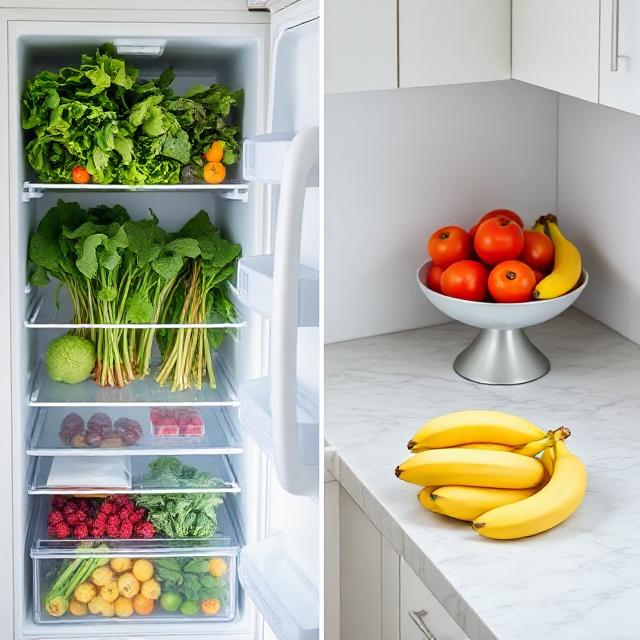
The Ultimate Guide to Produce Storage: Keeping Fruits and Vegetables Fresh
You work hard filling your fridge with fresh produce, but it too often wilts, spoils, and wastes your money. Learning how to store fruits and vegetables the right way will protect your investment and make meal prep actually work. This Shop Smart guide delivers a simple, science-backed system to keep produce fresher, longer.
Table of Contents
- The #1 Rule of Produce Storage: Separate Gassy Fruits from Sensitive Veggies
- Rule #1 Deep Dive: Mastering Ethylene Gas
- Rule #2: Master Temperature—The Fridge vs. The Counter
- Rule #3: Master Humidity—The Secret to Crisp Vegetables
- Your Smart Storage System for Fresher Food
- Frequently Asked Questions
- References
The #1 Rule of Produce Storage: Separate Gassy Fruits from Sensitive Veggies
This is the single most powerful rule in produce storage—and the biggest secret to stopping food waste. Watch the video below to see why separating ethylene gas-producing fruits from sensitive veggies can literally double your storage time for many foods.
Rule #1 Deep Dive: Mastering Ethylene Gas
The Ethylene Producers (The Ripeners)
- Apples (best stored away from greens)
- Bananas (ripen at room temp, then chill)
- Avocados (release lots of ethylene as they soften)
- Tomatoes (store at room temp until ripe)
- Kiwi, mangoes, peaches, pears, plums, cantaloupe
All these should be kept separated from broccoli, lettuce, and other leafy greens. For best results, keep ethylene producers in open bowls or their own fridge drawer.
The Ethylene Sensitive (The Spoilers)
- Leafy greens (romaine, spinach, arugula)
- Carrots
- Broccoli and cauliflower
- Cucumbers, zucchini, green beans
- Potatoes
The Action Plan: How to Keep Them Apart
- Assign one crisp drawer for “gassy” fruit and another for “sensitive” veggies.
- Store avocados and bananas away from salads and snack carrots.
- On the counter, use one bowl for apples/bananas and another for tomatoes.
- If possible, use fridge produce bags or vented containers for greens and beans. A little separation goes a very long way to reducing waste and keeping your produce fresh until you’re ready to use it.
Rule #2: Master Temperature—The Fridge vs. The Counter
The second rule for storing fruits and vegetables is knowing exactly which items need cool fridge air—and which stay best at room temperature.
The Fridge Dwellers (Love the Cold)
- Leafy greens (spinach, lettuce, kale)
- Broccoli, cauliflower, Brussels sprouts
- Celery and carrots
- Berries (strawberries, blueberries, raspberries)
- Grapes
- Peas, snap peas, green onions
- Cut or peeled fruit/veggies
The Countertop Crew (Hate the Cold)
- Tomatoes (become bland and mushy)
- Potatoes and sweet potatoes (fridge turns starches to sugar; get gritty)
- Onions and garlic (prefer dry dark storage)
- Winter squash (acorn, butternut, spaghetti)
- Bananas (darken quickly if cold)
- Whole avocados (until ripe)
Keep these on a counter or in a dry, dark cabinet, never in the fridge. Avoid plastic bags—a basket or mesh bag works best for air flow.
The "Ripen First" Group
- Avocados (move to fridge when perfectly soft)
- Mangoes, peaches, nectarines, apricots, plums, pears (once ripe)
- Kiwi (ripen at room temp, then chill for longer life)
- Bananas (ripen on counter, keep in fridge to slow blackening after ripe)
Rule #3: Master Humidity—The Secret to Crisp Vegetables
Humidity is the last, expert-level storage rule. Some produce loves dampness, while others spoil in it. Your fridge’s two crisper drawers aren’t just for storage—they’re humidity control tools.
High-Humidity Heroes (Need Moisture)
- Carrots (keep in a high-humidity crisper, in a bag with tiny holes)
- Leafy greens (lettuce, kale, spinach—use a damp paper towel in bag)
- Celery (wrap in foil or thick bag in crisper)
- Parsley, cilantro, other soft herbs (keep damp, upright in a jar)
Low-Humidity Lovers (Need to Breathe)
- Apples
- Pears
- Avocados (once ripe)
- Onions, garlic
- Stone fruit (peaches, nectarines, plums)
Your Smart Storage System for Fresher Food
With this 3-rule system—mastering ethylene, temperature, and humidity—you’re ready to keep produce fresh and your grocery budget strong.
Keeping gassy fruits apart, matching each item to its best temperature, and enjoying the right humidity means more meals prepped, fewer wilted greens, and no more wasted berries.
The simple steps inside this guide hold the key to better salads, tastier snacks, and a real reduction in food waste for your whole family.
Frequently Asked Questions
What fruits and vegetables should not be refrigerated?
Should fruits and vegetables be stored in the refrigerator?
How long can you store fruits and vegetables?
Storage time depends on the type. Leafy greens last 5–7 days in the fridge, carrots up to 2 weeks, apples several weeks in low humidity. Countertop items like tomatoes last 3–5 days; onions and potatoes can last a month in cool, dry conditions.
Should fruit be stored in airtight containers?
Should I wash my produce as soon as I get home?
What's the difference between the two crisper drawers in my fridge?
My potatoes started sprouting. Are they still safe to eat?
How can I keep herbs fresh for longer?
Is it okay to store onions and potatoes together in a pantry?
What is the best way to store cut fruits and vegetables?
References
- USDA. “Molds on Food: Are They Dangerous?”
- FDA. “Food Safety for Power Outages.”
- FoodSafety.gov. “Is it Still Safe to Eat?”
- CDC. “Eggs and Food Safety.”
- University of California, Davis. “Olive Oil Quality.”
- Penn State Extension. “Fermented Foods.”
- EatRight.org. “Deli Meat Safety.”
- University of Illinois Extension. “Refrigerated Food and Food Safety.”
- FDA. “Food Labeling and Storage.”
- National Center for Home Food Preservation. “Keeping Food Safe.”
- University of Maine. “Cheese and Food Safety.”
- North Dakota State University. “Food Storage Guide.”
